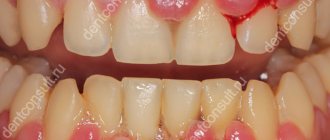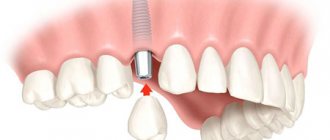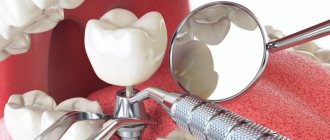Even patients who feel a panicky fear of visiting a dental office still turn to a dentist for help when they experience a piercing toothache caused by inflammation of the dental tissues. But inflammation of the gums near the tooth, which occurs without significant pain, usually remains unattended. Patients get used to its symptoms very quickly, not considering them a serious reason to go to the clinic.
Meanwhile, a separate section in dentistry deals with the study and treatment of gum diseases - periodontology. Periodontium is the complex of tissues surrounding the tooth, including, in addition to the gums, the bone tissue of the alveolus - the gingival socket, the periodontium connecting it to the tooth root, and the cementum of the tooth root.
According to statistics, patients in dental clinics much more often lose teeth not from caries, but from periodontal diseases, which are treated by a periodontist.
Who is a periodontist?
A periodontist is a highly qualified dentist with a higher medical education who specializes in the correction and prevention of pathologies of soft tissues that fix segments in the jaw bone. The concept of “periodontium” includes:
- mucous membranes that line the surface of the mouth;
- soft gum tissue surrounding the segments;
- periodontium is a thin layer of connective tissue between the alveolar process and the cementum of the tooth;
- dental cement - mineral tissue surrounding the root;
- alveolar process - a dental bed penetrated by capillaries and nerve endings.
How to choose a good periodontist?
The best recommendations for any doctor are good reviews from patients who have been treated by him. You must also pay attention:
- on his length and experience;
- the level of the medical institution, dentistry where he works;
- equipping the dental office with modern equipment.
Of no small importance is the doctor’s communication skills, willingness to tell you the details and nuances of treatment, participation and genuine interest in the condition of your teeth.
What diseases does a periodontist treat?
The area of expertise of a periodontist includes the treatment of gum diseases that have developed in periodontal tissues. The most common pathologies:
- Gingivitis is an inflammatory process of the periodontal soft tissues that occurs without disruption of the periodontal ligaments.
Only the gums are involved in the pathology. The first signs of the disease are bleeding and pain in the tissues surrounding the teeth. The pathology can occur in an acute form, which is also characterized by swelling, hyperemia of the mucous membrane, and itching. The chronic course of gingivitis causes virtually no discomfort, so a person is in no hurry to see a periodontist. Despite the asymptomatic course, the inflammatory process gradually progresses, complications arise - ulcerative-necrotic lesions, gum hypertrophy, detachment of mucosal areas, and others appear. The main cause of gingivitis is insufficient oral hygiene, which leads to the proliferation of bacteria. The periodontist usually prescribes conservative treatment, including removing plaque from teeth, using antiseptics, and antibiotics. - Periodontitis. Inflammatory periodontal disease, predominantly of an infectious nature. With periodontitis, destruction of the dentogingival ligaments occurs, and destruction of bone tissue develops. As the disease progresses, teeth begin to loosen and fall out. The disease is classified as polyetiological, since various reasons can lead to its development. Most often, the pathology develops due to the accumulation of bacterial plaque. In addition, periodontitis can occur due to poor heredity or gum injury. It often accompanies diabetes mellitus and is detected in hormonal disorders and other pathologies. A periodontist dentist, examining the mouth and jaw area, identifies the presence of periodontal pockets, bleeding, redness, swelling of the mucous membranes, and a heavy odor from the mouth.
- cavities. There is plaque on the teeth. Pus may be discharged from periodontal pockets. There is an exposure of the cervical zones of the segments, displacement of the teeth in the row, and their loosening. Treatment in the early stages is conservative, later - invasive.
- Periodontal disease. Non-inflammatory disease of periodontal tissues, characterized by a chronic course. The pathogenesis is based on circulatory dysfunction in the vessels supplying the periodontium. Violation of tissue trophism leads to the development of atrophic processes in the gum and bone tissues. Other causes of periodontal disease: malocclusion, smoking, decreased local immunity, hormonal imbalance, disruption of periodontal innervation, etc. The clinical picture of periodontal disease depends on the stage of the disease. Main symptoms: gum recession, pallor of the mucous membranes, increased spaces between units, their loosening. Bleeding gums are not typical for periodontal disease.
Treatment is aimed at strengthening the periodontium with the help of hygienic measures, drug therapy, and physiotherapy. If the degree is significant, the periodontist will suggest the surgeon
logical, orthopedic correction.
What functions does periodontal tissue perform?
Periodontal tissues perform 4 important functions:
- They serve as a support for the teeth, holding them firmly in the socket, and, due to the presence of collagen fibers, they cushion, evenly distributing the load when chewing food.
- They protect the tooth root from the penetration of pathogenic microflora, which can cause severe inflammation and significant pain.
- Due to the branched capillary network, blood microcirculation is ensured in accordance with the chewing load.
- They reflexively regulate chewing pressure due to nerve endings - receptors.
Periodontal tissues are easily injured by tartar, hot foods and drinks, spicy foods, toothpicks, etc., and the oral cavity is constantly home to several hundred varieties of pathogenic microorganisms. Therefore, the consequences of injuries are infectious inflammatory diseases - gingivitis and periodontitis. Gum inflammation often has a long course and leads to serious disruptions in the functioning of the digestive, endocrine and cardiovascular systems.
In addition, every third to fifth periodontist patient suffers from periodontal disease, a dystrophic disease that also leads to gum atrophy, the causes of which are still unclear.
When to contact a periodontist
Patients who come to see a therapist are most often sent to the periodontist's office. After listening to complaints, collecting anamnesis, examining the oral cavity and identifying symptoms characteristic of gum disease, he gives a referral to a highly specialized specialist who is more competent in solving such problems:
- mucous membranes bleed during hygiene measures after chewing
food ania; - mucous membranes have changed color and are swollen;
- discharge of pus is noticed;
- a putrid smell appeared;
- the sensitivity of units to external stimuli has increased;
- grayish-white spots appeared on the gums;
- The intersegmental spaces have widened and food debris has become more likely to get stuck in them;
- stony deposits have formed on the enamel of the segments, a soft coating in hard-to-reach areas that cannot be removed with home hygiene products;
- there is pain while eating;
- The volume of the gums has decreased, the necks of the teeth have become exposed;
- periodontal pockets have formed;
- the teeth began to loosen;
- the position of the segments in the row has changed.
The periodontist will conduct a thorough examination, determine the periodontal status, make a reliable diagnosis, and prescribe adequate treatment. The duration and range of manipulations depends on the neglect of the process.
After completing therapy, it is necessary to visit the doctor according to the prescribed schedule for a follow-up examination and, if necessary, repeat the course of periodontal intervention. Your periodontist will help you maintain the health of your gums so that your smile can once again be admired by others.
In what cases should I contact?
Detection of at least one of the following symptoms is a serious reason to consult a doctor:
- Bleeding gums - both provoked (by brushing teeth, eating, etc.) and spontaneous.
- Pain or discomfort in the gums.
- Change in gum color.
- The appearance of puffiness and swelling.
- Formation of plaque and tartar on the enamel.
- Bad breath.
- Inflammation or decay of the gingival margin.
- Increased sensitivity of teeth to cold and hot.
- Exposing the neck of the tooth.
Content:
- What does a periodontist treat 1.1. Periodontitis 1.2. Periodontal disease 1.3. Gingivitis 1.4. Cyst 1.5. Perioste 1.6. Pericoronitis
- Indications for visiting a periodontist
- Appointment with a periodontist
- What do periodontists usually recommend to their clients?
A periodontist is a doctor who treats periodontal pathologies. The latter refers to the tissues that surround the teeth and ensure their reliable fixation.
The periodontal system is formed by:
- gum;
- periodontium (layer between dental cement and the wall of the alveolar socket, consisting mainly of collagen fibers and holding the tooth in the alveolus);
- alveolar process (bone bed on which the units are located);
- root cement (specific bone tissue).
A periodontist belongs to the category of specialized specialists. He has in-depth knowledge of the treatment of oral soft tissue diseases. When conducting therapy, the doctor uses medical equipment, medicines, and instruments. To get positive dynamics, be sure to implement step-by-step diagnostics, which allows you to understand where the problem came from and how best to eliminate it.
What do periodontists usually recommend to their clients?
Periodontists focus on what is necessary:
- undergo annual preventive examinations in the dental office;
- do not delay in obtaining medical advice if symptoms of trouble arise;
- follow the rules of dental care;
- use a high-quality brush and paste;
- After each meal, rinse your teeth with water.
Take care of your smile, and then you won't have to be treated by a periodontist. After all, most dental diseases can be prevented with quality care.
Prices for services
Prices for periodontist services depend on the type and stage of the disease, the scope of treatment, the qualifications of the doctor, the location of the clinic and some other factors.
Approximate tariffs for some types of services
| Service | Price, rub |
| Consultation with a periodontist. | 500-00 |
| Hygiene training. | |
| Professional hygiene of PR (ultrasonic removal of dental plaque, remineralization, caries prevention). | 3000 |
| Treatment of periodontal pockets. | 1000 |
| Curettage of periodontal pocket (1 tooth). | 600 |
| Cable splinting. | 1600 |
| Gum retraction. | 600 |
| Bone tissue regeneration (Bio-Oss grafting). | 6000 |
Periodontitis
In dental practice, periodontitis occurs in 85% of patients after 35 years of age. The disease can occur in mild, moderate or severe stages, accompanied by inflammation of the tissues around the tooth, which can ultimately lead to its destruction. Against the background of periodontal inflammation, damage occurs to the gums, nerve endings, lymphatic and blood vessels, and bone tissue. The main cause of the disease is a bacterial infection, which, after penetration into the dental tissues, provokes inflammatory processes with the subsequent development of dental diseases.
Lack of treatment for periodontitis leads to destruction of the periodontium and alveolar bone tissue, looseness and loss of teeth. The danger lies in the fact that the disease can be cured only if there are no necrotic changes in the gums, bones and ligaments.
Peculiarities of the work of periodontists-surgeons
Soft tissue transplantation
Periodontal surgeons perform periodontal surgery. Types of surgical intervention on periodontal tissues include:
- removal of a gum pocket - resection of part of the gum that has separated from the tooth;
- gingivectomy – removal of the gum edge;
- soft tissue transplantation - suturing material taken from the palate into place of absorbed periodontal tissue;
- restoration of destroyed bone tissue - regeneration of resorbed bones using bone substitutes (Bio-Oss, etc.);
- gingivoplasty – formation (raising or lowering) of gum tissue;
- plastic surgery of the oral vestibule and frenulum.











